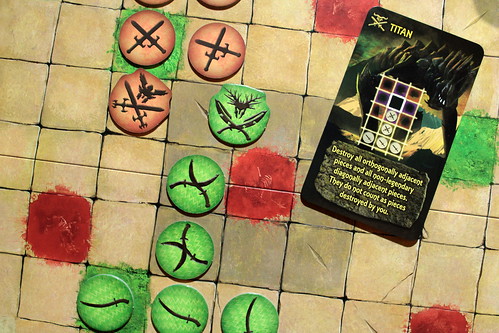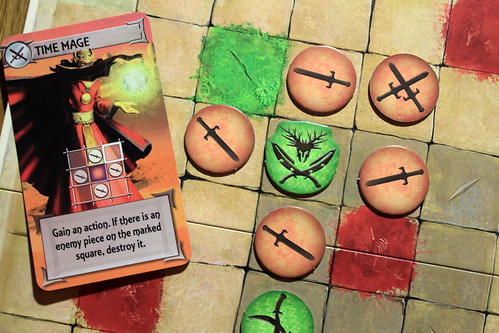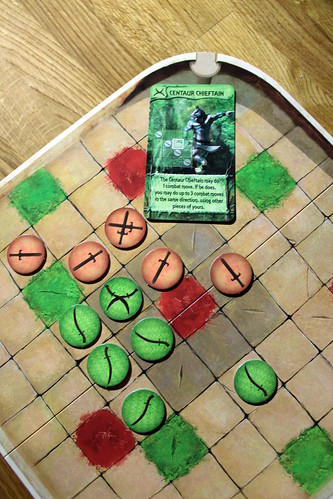| Strategy | Luck |
|---|---|
| Interaction | Components & Design |
| Complexity | Score |
With an annoyed flick of his wrist, Pri-Volat passed control of the battle to his partner on the other side of the arena. For the last ten minutes, all he had been able to do was summon single pieces of the mythical stone kalarite, without ever completing any of the complex summoning patterns running through his mind. Their opponents were disruptive. But maybe his decision to pass the turn to his partner would pay off, at least Ho-Ret had a very pleased expression on his face. A low hum of power filled the arena as Ho-Ret placed two more pieces of kalarite, the only thing he could do on Pri-Volat’s turn, but Pri-Volat thought he could see a pattern emerge.
So, honored wizards, when it’s your turn in the arena you may take two actions. As an action, you may summon a simple piece of kalarite into the arena, a so-called common piece. Those boring lumps of rock do nothing, won’t make you win the battle and won’t get the crowds cheering you on, either. Still, they are necessary, because they are what you use to create summoning patterns on the grid of the arena floor. And those patterns are where things get interesting, because they let you take the second type of action: play cards from your hands.
The opposing team had done some damage to their formation, but Ho-Ret was grinning like a squirrel that had discovered a coconut. Pri-Volat leaned forward in his summoner’s box to get a better view. This was going to be good. He felt a sharp tug on the lines of magical energy in the arena, a deep thrum ran through him. Definitely a bigger summoning spell, not another simple piece of kalarite. Probably not a common being either. A figure appeared in the arena, just for the blink of an eye, but it was enough to make the crowds gasp. The word beautiful didn’t do her justice, she was tall, slender and dressed only in leaves and her own, long hair. A Sylvan Queen, like in the old paintings. The ruler of the old forests, said to make any mortal fall instantly in love with her with a mere smile. She turned to one of the enemy pieces around here, and instantly it changed to their team’s color. Pri-Volat recognized a new pattern on the battlefield. A great pattern, a powerful pattern. A quick glance at their opponents’ dismayed faces told him that they recognized it as well.

Your hand cards represent various Beings to summon. Each card shows, next to the creatures name and beautiful illustration, its rank, the pattern required to summon it and the effect it will have on the battlefield. The rank of your hand cards is either Common, meaning the Being will turn into a regular piece of kalarite, or Heroic, having a stronger effect and creating a stronger magical focus. The pattern is shown in a grid and tells you what shape has to be on the board in order to summon this Being and where it will appear. Heroic Beings generally, but not always, have more complex summoning patterns, but they also bring a stronger effect. For instance the Herald, a Common Being, needs only three common pieces forming a right angle to be summoned, but his effect only lets you make two moves with your pieces. That’s far from earth-shattering, but it’s a great chance to form your pieces into a more elaborate pattern. The Master of Intrigue has to be summoned into the center of a square of four friendly pieces, but he lets you do three combat moves with those pieces – basically the same as regular moves, but you can also step on an enemy piece of the same or lower rank as yours and remove it from the board. Other Beings allow you to do regular or combat leaps – moves to any space on the board – to destroy whole blocks or lines of pieces, like the Bomb or the Cannon, or a variety of other effects described on the cards.
Contrary to recent trends, there is no deck-building involved. Tash-Kalar contains four fixed decks, one of which each player chooses at the start of the game. The red and blue decks, called the Northern and Southern Imperial Schools, are identical and contain everything an imperial fantasy army needs: soldiers, infantry, cavalry, mages, champions and assassins. Those two decks have a pretty well-rounded set of moves with some destruction and useful abilities to rearrange their pieces in the arena. The Highland School has a more barbaric approach to the game, they are very strong on destroying enemy pieces, but they don’t have the Imperial’s ability to regroup into new patterns, making complex patterns more difficult to create. The Highlanders are also the only deck that interacts with the green and red arena tiles, producing vastly superior effects when summoned on the right color. The Sylvan School, summoning Elves, fox-faced Kiskin and other forest-inhabitants, has the most complex actions of the four. They convert enemy pieces, pick from multiple possible card abilities, draw extra cards and may even get cards back from their discard pile.

There is another rank of Beings that do not belong in any deck: the Legendaries. You draw two of them at the start of the game, and it will take you some time to get them into play as they all require complex summoning patterns of common and heroic pieces. But once you get to summon them, they are so much fun. They have huge, game changing effects, like the Fire Dragon that destroys up to six non-legendary pieces in a cone of flame, or the Eldest Tree that can destroy enemy pieces and summon or upgrade your own pieces on squares around it. My personal favourite, however, may be the Time Elemental, which grants you a complete extra turn after your current one.
The arena shook with the power of the Being that Ho-Ret was calling forth. The ground split open and the giant, brutal shape of a burning Hell Bull sprang forth from it. The crowds, had been waiting with baited breath to see what creature would appear. At the sight of bos infernalis, they went wild. The roar of cheers and applaus almost drowned out the mad yell of the demonic cow. Almost. The Hell Bull pawed the ground. Once. Twice. Then it charged forward, trampling common and heroic pieces in its path alike. It came to a halt only when it met the other team’s legendary piece, the Titan that had brought Pri-Volat and Ho-Ret into their previous tough spot. And that piece, too, was ground to dust under the Bull’s hooves. When the beast was done, the cheers of the crowd were deafening.
Summoning creatures, trampling your enemy and driving them before you is obviously fun, but you also want to win the battle. How you do that depends on the type of game you play. The High Form, popular with the nobility, has Tasks to fulfil. Simple Tasks like destroying three enemy pieces in one turn, or hard tasks, like connecting opposite corners of the arena with a chain of your own pieces. The three available tasks are up for grabs to both players. When you complete a task, you take the card and score points for it, then a new task is added to the game. This form is somewhat civilised, you will of course destroy enemy pieces, but only when they are in your way. Not so in the Low Form, better known as Deathmatch. Here you play to the crowds and score points for pleasing them, mainly by destroying enemy pieces but also by summoning the impressive Legendary Beings. In this form, the constant summoning and killing make it challenging to create complex patterns, and the after-match cleanup crew demand much higher rates for their services, too.

The rulebook introduces Tash-Kalar as a two player game, one against one, mind against mind. But you can play in three or four players as well. Three player games only really work as a Deathmatch Melee, a big, free-for-all slaughterfest. You can do the same in four players, but you’d be wasting the opportunity to play Tash-Kalar‘s awesome team mode. While two player games are great and three player games sort of nice, four player team play is where this game really, really shines. All players still play their own deck, but each team only uses one color of pieces on the board, for creating summoning patterns it doesn’t matter if a piece was summoned by you or your partner. Each team also shares their two legendary cards. Players are not allowed to communicate about strategy, the only way to pass information is by passing control. That means that you give one or both of your actions to your partner, who may use them only to create common pieces on the board, not to play cards. It’s not much, but when you can do nothing useful then you give your partner a chance to prepare his move. You may also pass control after summoning a piece, but before resolving the card effect. In that case, your partner makes all decisions arising from that card. Getting your communication straight takes a bit of practice that way, knowing when to play and when to pass to your partner is tricky at times, but this mode of play is very satisfying indeed.
Me, I’m in love with Tash-Kalar, it’s another stone in Vlaada Chvátil’s legendary reputation. But it’s probably not a game for everyone because there is an unusual divide between theme and mechanics. The theme has magic, dragons and destruction in the arena, but the mechanics are not those of an arena battle game. Mechanically, Tash-Kalar is an abstract game with strong elements of pattern recognition. The situation of the arena is very dynamic, thanks to the various card effects, but you won’t get the feeling of commanding mighty creatures into battle, because you aren’t. So, if you’re after a game where your giant dragon wades into enemy lines breathing fire, you probably realized that this isn’t it before you read half this review. If, on the other hand, you enjoy abstract pattern-matching games, a fantasy theme and epic card illustrations, then you will have a hard time finding all those things packed in one box better than this one.
When Pri-Volat woke up the next morning, it was with a young woman in each arm and a hangover for the ages. What little money he had won was nowhere to be seen. He didn’t care much. If he wanted to be rich, he’d compete in the High Form. What he wanted was the cheers of the crowd and the admiration of the women. The money he could always win back later today.









